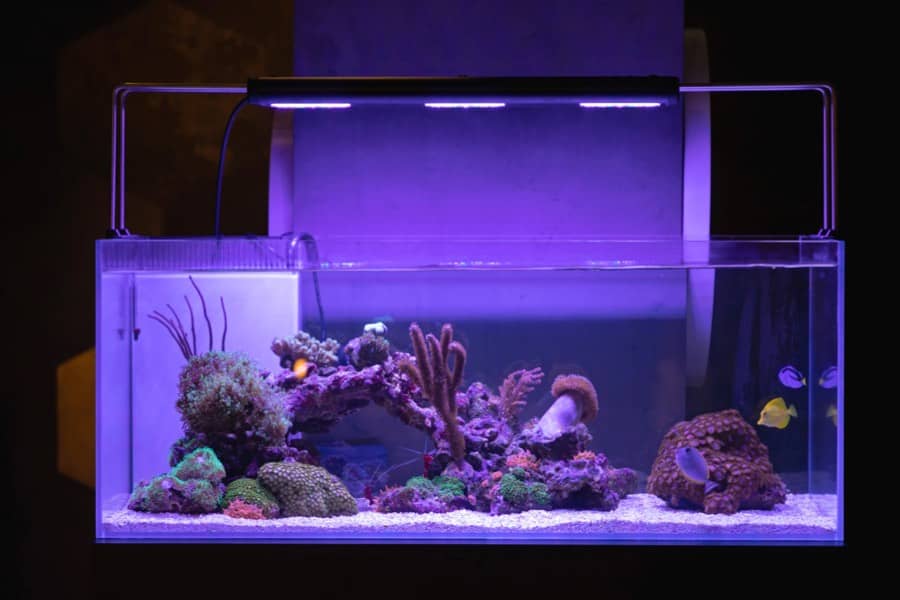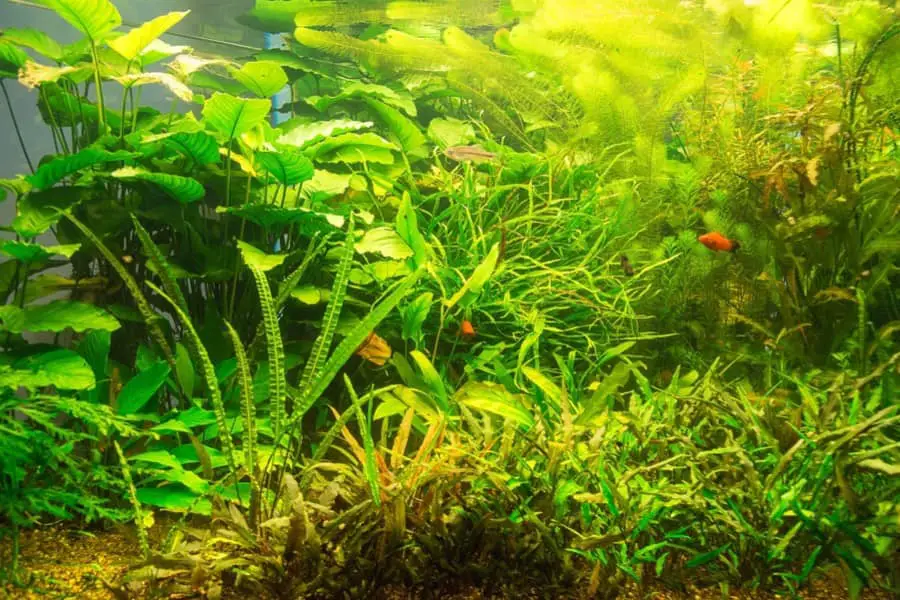Is Blue Light Good For Aquarium Plants?
 Blue light is commonly referred to as moonlight. Many aquarists use it for encouraging physical activity in nocturnal fish. But, is blue light good for aquarium plants?
Blue light is commonly referred to as moonlight. Many aquarists use it for encouraging physical activity in nocturnal fish. But, is blue light good for aquarium plants?
Blue light is good for aquarium plants as it is the most important part of the light spectrum for driving photosynthesis. Plants grown under blue light abundantly will have strong and healthy leaves and stems. Also, blue light enhances the color of aquatic plants which helps aquarium to look more rich and vibrant.
If you are new to moonlighting for aquariums and planning to go ahead with it, you may want to read this article. Here we have covered the benefits of blue light and how it may affect your aquatic plant life in the long run.
How Do Blue Light Affect Aquatic Plants?
The idea of blue light suppressing extension growth may seem vague unless you know how it is in works. To make it easy for you to understand, we have divided the whole conversation into 3 parts – overviewing how blue light impacts plants growth at different levels.
Plants Growth
When it comes to the indoor plantation, you need the low intensity of blue in a light spectrum for fully functional photosynthesis. However, the photosynthetic response to blue light highly varies among different species of plants. You can manipulate the growth by increasing or decreasing the amount of blue within a spectrum.
One of the notable characteristics of blue light is it suppresses extension growth. Now, why is it so? Blue light is the indicator of high-intensity light. It means, even if kept at minimal intensity, blue light is perceived by plants as of high intensity.
In layman’s terms, when a plant is receiving all the light it needs in the early stages of development, there is no motivation to grow larger leaves to collect more sunlight.
Plants grown with blue light are usually shorter and have increased leaf thickness; it is essentially the desirable attribute for ornamental production.
Blue light mainly acts as a growth regulator and/or supplementary lighting as it allows you to regulate and modify the overall plant’s development.
Leaf Color
Plants exposed to radiation with shorter wavelengths, such as blue light, generally have a notable difference in leaf coloration.
When you put plants under intense light or blue light at low intensities, it stimulates the production of anthocyanins. It is the naturally occurring pigments responsible for red-blue pigment found in plants. In acidic conditions, anthocyanin appears as a red pigment, while in alkaline conditions, it appears as a blue pigment.
In simple terms, blue light causes plant leaves to be darker in color.
Flowering
As you may know, plants mostly absorb the blue and red colors of a light spectrum. You must understand, different color of light helps plants achieve different goals.
Blue light promotes strong, healthy stems & leaves and has better penetration ability in the water. Whereas red light helps plants flower and give a stretched and elongated appearance.
If your plants are only exposed to blue light at low intensity, you may not have the best of flowering.
However, high-intensity blue light can promote the flowering of long-day plants while inhibiting the flowering of short-day plants.
Having a clear understanding of the plant species will help you decide the spectrum it requires for healthy growth.
What Are Benefits of Blue Light In An Aquarium?
If you are planning to install blue light in your aquarium, you might be interested in knowing what all benefits it offers.
As we know, blue is an essential part of the light spectrum used for photosynthesizing plants. Blue light has a shorter wavelength; therefore, it can penetrate deeper.
Planted tanks with high depth usually benefit from blue light as it reaches down to roots and stimulates growth. Blue light helps plants to become bushier and reach a denser vegetative state. Furthermore, it enhances the leaf coloration and contrast.

The other job of blue light is to give the appearance of natural moonlight in an aquarium. It offers nocturnal fish the illumination they might need to act during the nighttime. Under dim blue light, you can watch your fish and feed them. Moreover, it helps provide comfort to diurnal species that might get scared in complete darkness.
Blue light can be used as a transition light between dawn and dusk. A sudden transition from bright to dark as the night falls can be stressful to the fish. So having a moonlight installed in your tank certainly helps with this case.
Last but not least, blue light enhances the nighttime appearance of your tank. It can be a very soothing experience to gaze at.
Does Blue Light Cause Algae In Fish Tanks?

Any light (regardless of its color) that encourages plant growth can cause algae. You must understand, algae growth has nothing to do with the color of the light; white or red lighting can produce algae blooms as much as blue lighting.
To reduce the chances of algae, you have to balance the light intensity, carbon availability, and fertilizers. When there is too much light in an aquarium, plants require more CO2 and nutrients. If the demand is not met or balanced, you get algae in your tank. Having high-powered lights left on for many hours a day is one of the main reasons for algae nuisance.
If you have blue LED lighting in your fish tank and you are experiencing algae issues. You can be assured knowing that it’s not a result of the spectrum being blue but rather the lighting intensity or other stated factors. Using moonlights for a few hours shouldn’t cause any issue.
Related Questions
Q. Which color light is better for an aquarium?
Usually, plants require a full spectrum of light for healthy growth. If you are dealing with exotic species, you may need a spectrum more tailored to the requirement of the plant. One thing to keep in mind, there is no one “best lighting system.” You should opt for lights that are more suitable to the inhabitants’ needs and user preferences.
Q. How do fish react to blue light?
Blue lights have a calming effect on the fish. However, sometimes fish get freaked out as they see each other color differently in blue light. So you may face some aggression issues in the early days until your fish get used to the blue effect.
Q. Is Blue Light Bad For Aquarium Fish?
Blue light can be bad for your aquarium fish if it’s not correctly used. It’s important to not leave blue or other lightning systems on for more than 8-12 hours.
Q. Which blue light is best for planted aquariums?
You can buy pretty much any aquarium-grade LED that has blue light incorporated. Nowadays, you can easily find the moonlight mode available in modern LED lights.
Conclusion
If you are still with us, we hope by now you are crystal clear on your basics about whether or not blue light is suitable for aquarium plants. We tried our best to bring you reliable information based on our experience and the hands-on experiences of many other hobbyists.
